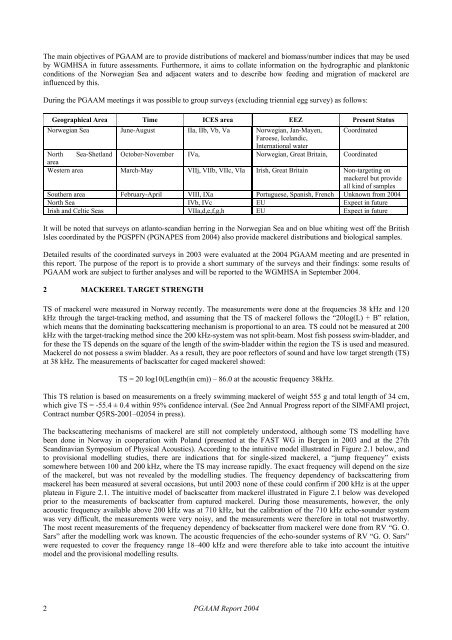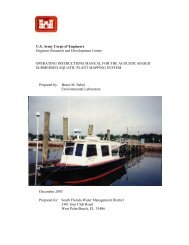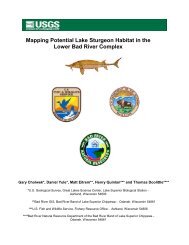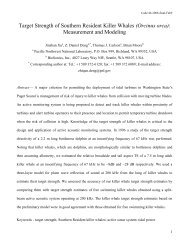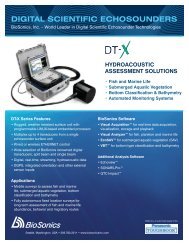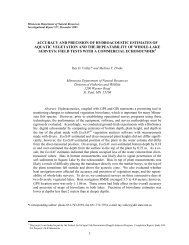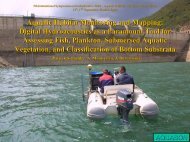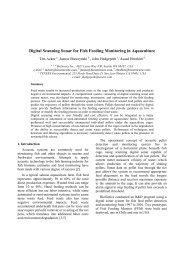Aerial and Acoustic Surveys for Mackerel - BioSonics, Inc
Aerial and Acoustic Surveys for Mackerel - BioSonics, Inc
Aerial and Acoustic Surveys for Mackerel - BioSonics, Inc
Create successful ePaper yourself
Turn your PDF publications into a flip-book with our unique Google optimized e-Paper software.
The main objectives of PGAAM are to provide distributions of mackerel <strong>and</strong> biomass/number indices that may be used<br />
by WGMHSA in future assessments. Furthermore, it aims to collate in<strong>for</strong>mation on the hydrographic <strong>and</strong> planktonic<br />
conditions of the Norwegian Sea <strong>and</strong> adjacent waters <strong>and</strong> to describe how feeding <strong>and</strong> migration of mackerel are<br />
influenced by this.<br />
During the PGAAM meetings it was possible to group surveys (excluding triennial egg survey) as follows:<br />
Geographical Area Time ICES area EEZ Present Status<br />
Norwegian Sea June-August IIa, IIb, Vb, Va Norwegian, Jan-Mayen, Coordinated<br />
Faroese, Icel<strong>and</strong>ic,<br />
International water<br />
North Sea-Shetl<strong>and</strong> October-November IVa, Norwegian, Great Britain, Coordinated<br />
area<br />
Western area March-May VIIj, VIIb, VIIc, VIa Irish, Great Britain Non-targeting on<br />
mackerel but provide<br />
all kind of samples<br />
Southern area February-April VIII, IXa Portuguese, Spanish, French Unknown from 2004<br />
North Sea IVb, IVc EU Expect in future<br />
Irish <strong>and</strong> Celtic Seas VIIa,d,e,f,g,h EU Expect in future<br />
It will be noted that surveys on atlanto-sc<strong>and</strong>ian herring in the Norwegian Sea <strong>and</strong> on blue whiting west off the British<br />
Isles coordinated by the PGSPFN (PGNAPES from 2004) also provide mackerel distributions <strong>and</strong> biological samples.<br />
Detailed results of the coordinated surveys in 2003 were evaluated at the 2004 PGAAM meeting <strong>and</strong> are presented in<br />
this report. The purpose of the report is to provide a short summary of the surveys <strong>and</strong> their findings: some results of<br />
PGAAM work are subject to further analyses <strong>and</strong> will be reported to the WGMHSA in September 2004.<br />
2 MACKEREL TARGET STRENGTH<br />
TS of mackerel were measured in Norway recently. The measurements were done at the frequencies 38 kHz <strong>and</strong> 120<br />
kHz through the target-tracking method, <strong>and</strong> assuming that the TS of mackerel follows the “20log(L) + B” relation,<br />
which means that the dominating backscattering mechanism is proportional to an area. TS could not be measured at 200<br />
kHz with the target-tracking method since the 200 kHz-system was not split-beam. Most fish possess swim-bladder, <strong>and</strong><br />
<strong>for</strong> these the TS depends on the square of the length of the swim-bladder within the region the TS is used <strong>and</strong> measured.<br />
<strong>Mackerel</strong> do not possess a swim bladder. As a result, they are poor reflectors of sound <strong>and</strong> have low target strength (TS)<br />
at 38 kHz. The measurements of backscatter <strong>for</strong> caged mackerel showed:<br />
TS = 20 log10(Length(in cm)) – 86.0 at the acoustic frequency 38kHz.<br />
This TS relation is based on measurements on a freely swimming mackerel of weight 555 g <strong>and</strong> total length of 34 cm,<br />
which give TS = -55.4 ± 0.4 within 95% confidence interval. (See 2nd Annual Progress report of the SIMFAMI project,<br />
Contract number Q5RS-2001–02054 in press).<br />
The backscattering mechanisms of mackerel are still not completely understood, although some TS modelling have<br />
been done in Norway in cooperation with Pol<strong>and</strong> (presented at the FAST WG in Bergen in 2003 <strong>and</strong> at the 27th<br />
Sc<strong>and</strong>inavian Symposium of Physical <strong>Acoustic</strong>s). According to the intuitive model illustrated in Figure 2.1 below, <strong>and</strong><br />
to provisional modelling studies, there are indications that <strong>for</strong> single-sized mackerel, a “jump frequency” exists<br />
somewhere between 100 <strong>and</strong> 200 kHz, where the TS may increase rapidly. The exact frequency will depend on the size<br />
of the mackerel, but was not revealed by the modelling studies. The frequency dependency of backscattering from<br />
mackerel has been measured at several occasions, but until 2003 none of these could confirm if 200 kHz is at the upper<br />
plateau in Figure 2.1. The intuitive model of backscatter from mackerel illustrated in Figure 2.1 below was developed<br />
prior to the measurements of backscatter from captured mackerel. During those measurements, however, the only<br />
acoustic frequency available above 200 kHz was at 710 kHz, but the calibration of the 710 kHz echo-sounder system<br />
was very difficult, the measurements were very noisy, <strong>and</strong> the measurements were there<strong>for</strong>e in total not trustworthy.<br />
The most recent measurements of the frequency dependency of backscatter from mackerel were done from RV “G. O.<br />
Sars” after the modelling work was known. The acoustic frequencies of the echo-sounder systems of RV “G. O. Sars”<br />
were requested to cover the frequency range 18–400 kHz <strong>and</strong> were there<strong>for</strong>e able to take into account the intuitive<br />
model <strong>and</strong> the provisional modelling results.<br />
2<br />
PGAAM Report 2004


